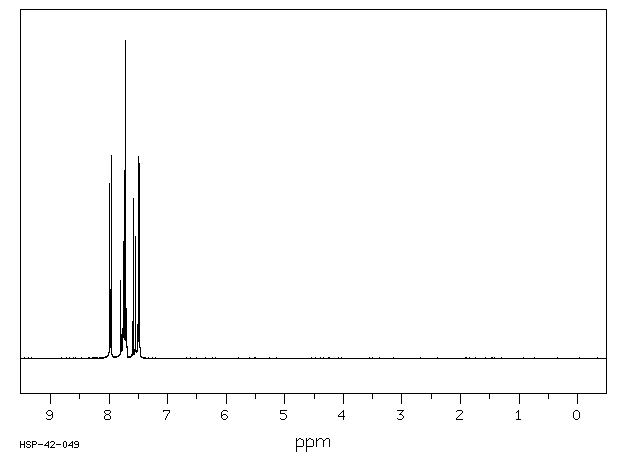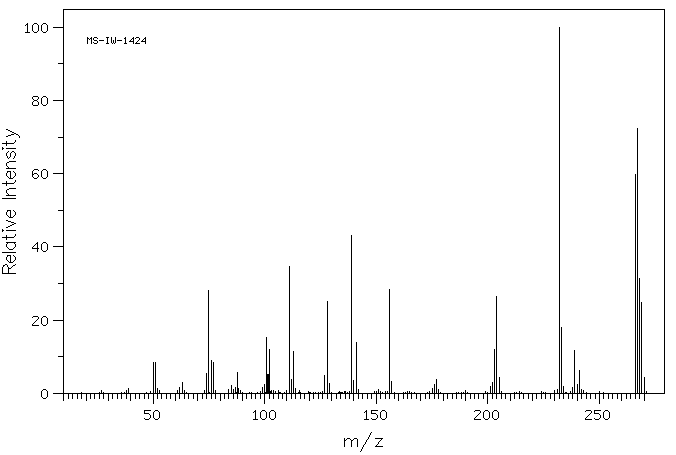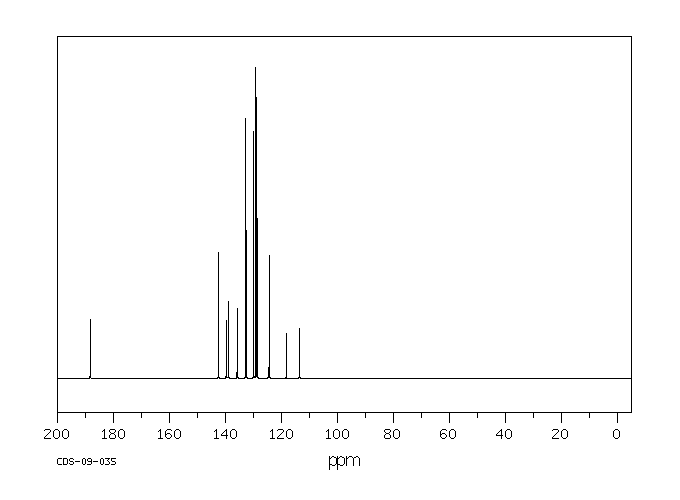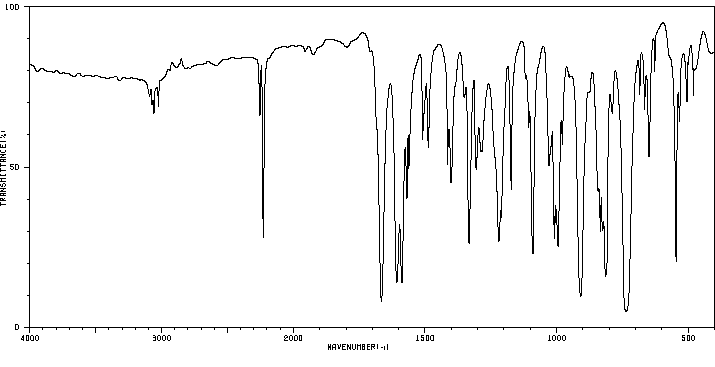4-[3-(4-chloro-phenyl)-3-oxo-trans-propenyl]-benzonitrile | 126443-35-4
分子结构分类
中文名称
——
中文别名
——
英文名称
4-[3-(4-chloro-phenyl)-3-oxo-trans-propenyl]-benzonitrile
英文别名
4-[3-(4-Chlor-phenyl)-3-oxo-trans-propenyl]-benzonitril;trans-p-(3-(p-Chlorophenyl)-3-oxo-1-propenyl)benzonitrile;4-[(E)-3-(4-chlorophenyl)-3-oxoprop-1-enyl]benzonitrile
CAS
126443-35-4
化学式
C16H10ClNO
mdl
——
分子量
267.714
InChiKey
KSPUPHDQJGCQCN-BJMVGYQFSA-N
BEILSTEIN
——
EINECS
——
-
物化性质
-
计算性质
-
ADMET
-
安全信息
-
SDS
-
制备方法与用途
-
上下游信息
-
文献信息
-
表征谱图
-
同类化合物
-
相关功能分类
-
相关结构分类
计算性质
-
辛醇/水分配系数(LogP):3.4
-
重原子数:19
-
可旋转键数:3
-
环数:2.0
-
sp3杂化的碳原子比例:0.0
-
拓扑面积:40.9
-
氢给体数:0
-
氢受体数:2
上下游信息
-
下游产品
中文名称 英文名称 CAS号 化学式 分子量 —— 4-(3-(4-chlorophenyl)-3-oxopropyl)benzonitrile 62584-74-1 C16H12ClNO 269.73
反应信息
-
作为反应物:参考文献:名称:WAGNER G.; VOIGT B., PHARMAZIE
, 1976, 31, NO 8, 528-532 摘要:DOI: -
作为产物:描述:对氯苯乙酮 、 4-氰基苯甲醛 在 sodium hydroxide 作用下, 以 甲醇 为溶剂, 反应 0.67h, 生成 4-[3-(4-chloro-phenyl)-3-oxo-trans-propenyl]-benzonitrile参考文献:名称:研究一系列合成查耳酮对酵母白色念珠菌的取代基作用。摘要:合成了大量查耳酮,并研究了其对白色念珠菌的活性。SAR分析表明,抗真菌活性高度依赖于芳基环的取代方式,并在很大程度上与化合物与巯基相互作用的能力有关。最具活性的是羟基化查耳酮,因为它们的活性与芳基环B中酚基的位置有关,如下所示:o-OH> p-OH约为3,4-di-OH> m-OH。获得的这些相关性和其他相关性极大地有助于设计抗候选查耳酮。DOI:10.1016/j.ejmech.2006.08.012
文献信息
-
<i>N</i>-Heterocyclic Carbene-Catalyzed Reaction of Chalcones and Enals via Homoenolate: an Efficient Synthesis of 1,3,4-Trisubstituted Cyclopentenes作者:Vijay Nair、Sreekumar Vellalath、Manojkumar Poonoth、Eringathodi SureshDOI:10.1021/ja0625677日期:2006.7.1Nucleophilic heterocyclic carbene-catalyzed cyclopentannulation of enals and chalcones via homoenolate has been observed for the first time. Serendipitously, the reaction lead to a very efficient synthesis of 3,4-trans-disubstituted-1-aryl cyclopentenes instead of the expected cyclopentanones. The strategy works well with thienylidene tetralone also, leading to the tricyclic cyclopentene derivative
-
Kanthi; Nargund, Journal of the Karnatak University, 1957, vol. 2, p. 8,10作者:Kanthi、NargundDOI:——日期:——
-
Antifungal activity of chalcones: A mechanistic study using various yeast strains作者:K.L. Lahtchev、D.I. Batovska、St.P. Parushev、V.M. Ubiyvovk、A.A. SibirnyDOI:10.1016/j.ejmech.2007.12.027日期:2008.10We reported the synthesis, antifungal evaluation and study on substituent effects of 21 chalcones. A lot of genetically defined strains belonging to different yeast genera and species, namely Saccharomyces cerevisiae, Hansenula polymorpha and Kluyveromyces lactis, were used as test organisms. Concerning the mode of the antifungal action of chalcones it was shown that DNA was probably not the main target for the chalcones. It was revealed that the yeast's intracellular glutathione and cysteine molecules play significant role as defence barrier against the chalcone action. It was also shown that chalcones may react with some proteins involved in cell separation. (C) 2008 Elsevier Masson SAS. All fights reserved.
表征谱图
-
氢谱1HNMR
-
质谱MS
-
碳谱13CNMR
-
红外IR
-
拉曼Raman
-
峰位数据
-
峰位匹配
-
表征信息
同类化合物
(2Z)-1,3-二苯基-2-丙烯-1-酮,2-丙烯-1-酮,1,3-二苯基-,(2Z)-
龙血素D
龙血素A
龙血素 B
黄色当归醇F
黄色当归醇B
黄腐醇; 黄腐酚
黄腐醇 D; 黄腐酚 D
黄腐酚B
黄腐酚
黄腐酚
黄卡瓦胡椒素 C
高紫柳查尔酮
阿普非农
阿司巴汀
阿伏苯宗
金鸡菊查耳酮
邻肉桂酰苯甲酸
达泊西汀杂质25
豆蔻明
补骨脂色烯查耳酮
补骨脂查耳酮
补骨脂呋喃查耳酮
补骨脂乙素
蜡菊亭; 4,2',4'-三羟基-6'-甲氧基查耳酮
苯酚,4-[3-(2-羟基苯基)-1-苯基丙基]-2-(3-苯基丙基)-
苯磺酰胺,N-[4-[3-(3-羟基苯基)-1-羰基-2-丙烯基]苯基]-
苯磺酰胺,N-[3-[3-(4-羟基-3-甲氧苯基)-1-羰基-2-丙烯基]苯基]-
苯磺酰胺,4-甲氧基-N,N-二甲基-2-(3-羰基-3-苯基-1-丙烯基)-,(E)-
苯磺酰氯化,4,5-二甲氧基-2-(3-羰基-3-苯基-1-丙烯基)-,(E)-
苯磺酰氯,4-甲氧基-3-(3-羰基-3-苯基-1-丙烯基)-,(E)-
苯甲醇,4-甲氧基-a-[2-(4-甲氧苯基)乙烯基]-
苯甲酸-[4-(3-氧代-3-苯基-丙烯基)-苯胺]
苯甲酸,3-[3-(4-溴苯基)-1-羰基-2-丙烯基]-4-羟基-
苯甲酰(2-羟基苯酰)甲烷
苯甲腈,4-(1-羟基-3-羰基-3-苯基丙基)-
苯基[2-(1-萘基)乙烯基]甲酮
苯基-(三苯基-丙-2-炔基)-醚
苯基-(2-苯基-2,3-二氢-苯并噻唑-2-基)-甲酮
苯亚甲基苯乙酮
苯乙酰腈,a-(1-氨基-2-苯基亚乙基)-
苯丙酸,a-苯甲酰-b-羰基-,苯基(苯基亚甲基)酰肼
苯,1-(2,2-二甲基-3-苯基丙基)-2-甲基-
苏木查耳酮
苄桂哌酯
苄基(4-氯-2-(3-氧代-1,3-二苯基丙基)苯基)氨基甲酸酯
芦荟提取物
腈苯唑
胀果甘草宁C
聚磷酸根皮酚










